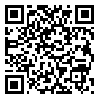Volume 16, Issue 2 (March & April 2025)
BCN 2025, 16(2): 441-448 |
Back to browse issues page
Download citation:
BibTeX | RIS | EndNote | Medlars | ProCite | Reference Manager | RefWorks
Send citation to:



BibTeX | RIS | EndNote | Medlars | ProCite | Reference Manager | RefWorks
Send citation to:
Mehvari J, Jaafari Z, Zare M, Tabrizi N, Khosravi Farsani A. Assessing Electrocardiographic Parameters in the Patients With Drug-resistant Temporal Lobe Epilepsy: A Case-control Study. BCN 2025; 16 (2) :441-448
URL: http://bcn.iums.ac.ir/article-1-2556-en.html
URL: http://bcn.iums.ac.ir/article-1-2556-en.html
1- Department of Neurology, School of Medicine, Isfahan University of Medical Sciences, Isfahan, Iran.
2- Department of Neurology, School of Medicine, Mazandaran University of Medical Sciences, Sari, Iran.
3- Department of Cardiology, School of Medicine, Isfahan University of Medical Sciences, Isfahan, Iran.
2- Department of Neurology, School of Medicine, Mazandaran University of Medical Sciences, Sari, Iran.
3- Department of Cardiology, School of Medicine, Isfahan University of Medical Sciences, Isfahan, Iran.
Abstract:
Introduction: Sudden, unexpected death in epilepsy (SUDEP) is a substantial cause of death in patients with epilepsy. Although electroconductive disorders leading to life-threatening arrhythmia are supposed to play a crucial role, there is a paucity of knowledge in variables among the patients with drug-resistant temporal lobe epilepsy (TLE) compared to the healthy controls.
Methods: The current case-control study has been conducted on 50 drug-resistant TLE patients as the cases and 50 age- and gender-matched healthy subjects selected from their first-degree family members. Electrocardiographic (ECG) were taken from the cases when admitted at the hospital (baseline), immediately after a seizure incidence, and within an hour after the end of the seizure and compared with a random ECG of the controls considering parameters, including PR-, RR-, and corrected QT interval (QTc), P wave duration, and heart rate (HR) variability.
Results: A shorter corrected QTc interval was notified among the drug-resistant TLE patients compared to the controls (P=0.017) in the baseline taken ECGs, while the assessments immediately after the seizure revealed significant differences in terms of RR-interval (P=0.005) and HR (P=0.005). Postictal ECGs did not differ between the groups (P>0.05).
Conclusion: According to the findings of this study, shortened QTc interval at baseline ECGs, shortened RR interval, and increased HR during the seizure were the ECG elements that affected drug-resistant TLE patients; however, to generalize the outcomes, further studies are required.
Methods: The current case-control study has been conducted on 50 drug-resistant TLE patients as the cases and 50 age- and gender-matched healthy subjects selected from their first-degree family members. Electrocardiographic (ECG) were taken from the cases when admitted at the hospital (baseline), immediately after a seizure incidence, and within an hour after the end of the seizure and compared with a random ECG of the controls considering parameters, including PR-, RR-, and corrected QT interval (QTc), P wave duration, and heart rate (HR) variability.
Results: A shorter corrected QTc interval was notified among the drug-resistant TLE patients compared to the controls (P=0.017) in the baseline taken ECGs, while the assessments immediately after the seizure revealed significant differences in terms of RR-interval (P=0.005) and HR (P=0.005). Postictal ECGs did not differ between the groups (P>0.05).
Conclusion: According to the findings of this study, shortened QTc interval at baseline ECGs, shortened RR interval, and increased HR during the seizure were the ECG elements that affected drug-resistant TLE patients; however, to generalize the outcomes, further studies are required.
Keywords: Sudden unexpected death in epilepsy (SUDEP), Temporal lobe epilepsy (TLE), Cardiac arrhythmia, Electrocardiography (ECG)
Type of Study: Original |
Subject:
Clinical Neuroscience
Received: 2023/10/8 | Accepted: 2024/07/10 | Published: 2025/03/11
Received: 2023/10/8 | Accepted: 2024/07/10 | Published: 2025/03/11
Send email to the article author
| Rights and permissions | |
 |
This work is licensed under a Creative Commons Attribution-NonCommercial 4.0 International License. |








